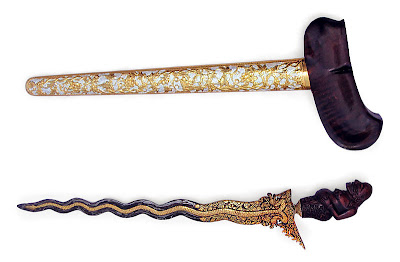The kris or keris is an asymmetrical dagger or sword nowadays most strongly associated with the culture of Indonesia, but also indigenous to Malaysia, Southern Thailand and Brunei. It is known as kalis in the southern Philippines. The kris is famous for its distinctive wavy blade (luk), but many have straight blades as well. The numbers of luks is always odd numbered, ranged from three to thirteen waves, however there is also luks that reach 29. Kris can be divided into three parts: wilah (blade), hulu (hilt), and warangka (sheath). These parts of kris are the object of art, often carved in meticulous details and made from various materials; metal, precious rare types of wood to gold or ivory. A kris' aesthetic value covers the dhapur (the form and design of the blade, with around 150 variants), the pamor (the pattern of metal alloy decoration on the blade, with around 60 variants), and tangguh referring to the age and origin of a kris.
Both a weapon and spiritual object, kris are often considered to have an essence or presence, often considered to possess magical powers, with some blades possessing good luck and others possessing bad. Krises are used for display, as talismans with magical powers, weapons, sanctified heirloom (pusaka), auxiliary equipment for court soldiers, as an accessory for ceremonial dress, an indicator of social status, a symbol of heroism, etc. Legendary krisses that possess supernatural power and extraordinary ability were mentioned in traditional folktales, such as the krisses of Mpu Gandring, Taming Sari, and Setan Kober.
Both a weapon and spiritual object, kris are often considered to have an essence or presence, often considered to possess magical powers, with some blades possessing good luck and others possessing bad. Krises are used for display, as talismans with magical powers, weapons, sanctified heirloom (pusaka), auxiliary equipment for court soldiers, as an accessory for ceremonial dress, an indicator of social status, a symbol of heroism, etc. Legendary krisses that possess supernatural power and extraordinary ability were mentioned in traditional folktales, such as the krisses of Mpu Gandring, Taming Sari, and Setan Kober.


keris bapak gua ada tuh, sakti banget katanya dulu buat perang pas majapahit :D
BalasHapus